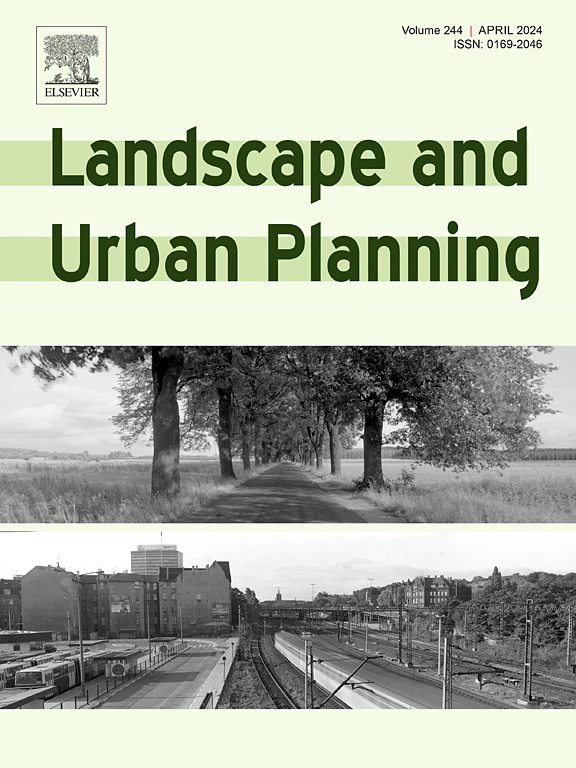Understanding incremental densification – Determinants of residential infill on vacant lots
IF 9.2
1区 环境科学与生态学
Q1 ECOLOGY
引用次数: 0
Abstract
Urban densification faces challenges due to the declining availability of land in urban areas worldwide and the need to balance various demands regarding the use of the remaining land, which can provide high ecological and social value. At the same time, in many residential areas, small-scale vacant lots with existing building rights can be found. The decision as to whether or not densification on these lots takes place depends on individual landowners’ decisions and takes place largely without the purview of strategic planning. Although small-scale densification potentials and processes can add up to substantial amounts, they remain poorly studied. With this study, we aim to contribute to a better understanding of which determinants drive or limit small-scale incremental densification processes on vacant lots. We employ logistic regression analysis using detailed infill data from 2011 to 2021 for the three main processes found: Vacant lots staying vacant, infill with low-density housing, and infill with multi-family housing. Applied to a German study area, we obtain good model results for infill with multi-family housing (AUC: 0.82) which showed to be highly dependent on parcel characteristics, limited by planning regulations, and driven by market interests. In contrast, the model results for low-density housing infill were rather poor, indicating the importance of individual landowner interests as well as the minor impact of market rationalities, spatial preconditions, and planning regulations. However, the predominant process observed in the study area was that vacant lots remained undeveloped, highlighting the enduring presence of urban vacant land despite the existence of building rights. The study contributes to understanding the complex dynamics of decentralised densification processes and highlights the need for nuanced approaches to incremental densification, considering landowner interests and regulatory frameworks.
理解增量密度——空地上住宅填充的决定因素
由于全球城市地区土地可用性的下降以及需要平衡关于剩余土地使用的各种需求,城市致密化面临着挑战,这些土地可以提供高生态和社会价值。与此同时,在许多居民区,可以找到具有现有建筑权利的小规模空地。是否在这些土地上进行密集化的决定取决于个别土地所有者的决定,并且在很大程度上没有战略规划的范围。虽然小规模的致密化电位和过程加起来可以达到相当大的数量,但对它们的研究仍然很少。通过这项研究,我们的目标是有助于更好地理解哪些决定因素驱动或限制空地上的小规模增量致密化过程。我们使用2011年至2021年的详细填充数据对三个主要过程进行了逻辑回归分析:空置地块保持空置,填充低密度住房,填充多户住房。应用于德国研究区域,我们得到了良好的多户住宅填充模型结果(AUC: 0.82),显示出高度依赖地块特征,受规划法规限制,受市场利益驱动。相比之下,低密度住房填充的模型结果相当差,表明土地所有者个人利益的重要性,而市场理性、空间前提条件和规划法规的影响较小。然而,在研究区域观察到的主要过程是空置土地仍未开发,突出表明尽管存在建筑权利,但城市空置土地的长期存在。该研究有助于理解分散致密化过程的复杂动态,并强调需要采用细致入微的方法来实现增量致密化,同时考虑到土地所有者的利益和监管框架。
本文章由计算机程序翻译,如有差异,请以英文原文为准。
求助全文
约1分钟内获得全文
求助全文
来源期刊

Landscape and Urban Planning
环境科学-生态学
CiteScore
15.20
自引率
6.60%
发文量
232
审稿时长
6 months
期刊介绍:
Landscape and Urban Planning is an international journal that aims to enhance our understanding of landscapes and promote sustainable solutions for landscape change. The journal focuses on landscapes as complex social-ecological systems that encompass various spatial and temporal dimensions. These landscapes possess aesthetic, natural, and cultural qualities that are valued by individuals in different ways, leading to actions that alter the landscape. With increasing urbanization and the need for ecological and cultural sensitivity at various scales, a multidisciplinary approach is necessary to comprehend and align social and ecological values for landscape sustainability. The journal believes that combining landscape science with planning and design can yield positive outcomes for both people and nature.
 求助内容:
求助内容: 应助结果提醒方式:
应助结果提醒方式:


